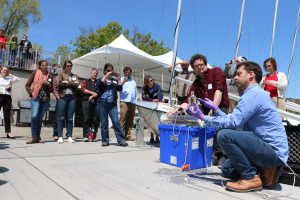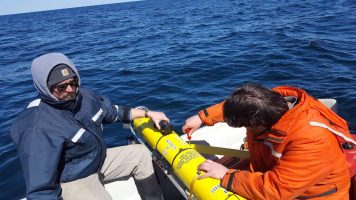PROJECTS
In addition to funding our regional network of observing assets, NERACOOS partners with organizations throughout the Northeast to…
- Engage & serve our regional community
- Work with stakeholders to identify problems & find solutions
- Pilot new technology
- Add variables to our observing portfolio
- Increase regional observing capacity
- Advance understanding of coastal, ocean & ecosystem processes



ONGOING PROJECTS
Scroll down or click to visit the project archiveOVERVIEW: NERACOOS is the Northeastern “branch” or Regional Association of U.S. IOOS, a program of NOAA, and our primary directive–you could say it’s our main project– is fulfilling the goals set forth by IOOS. Learn more about IOOS here.
The ways in which we fulfill our and IOOS’s mission are driven by the needs our stakeholders communicate to us; using buoys, high frequency radar, gliders, tide stations, coastal monitoring stations, and models, NERACOOS provides support for ocean scientists to:
-Produce ocean observations and models: We launch and maintain equipment that can gather and transmit information about ocean conditions, and support models that increase our understanding of past and future weather events
-Integrate new and historic data/information: We provide people with tools that make it easy to access and visualize data of all kinds, from real-time ocean conditions to forecasts to historical trends
-Facilitate regional collaboration: We bring together other people and groups who are working on similar things to make all of our efforts better and more impactful
WHO’S INVOLVED: Get to know our Partners and System Operators
TIMELINE: 2010-2021; renewed in 2021 to fund through 2026
FUNDING PROVIDED BY: U.S. IOOS
(ISMN has its own website: www.sentinelmonitoring.org)
OVERVIEW: Climate change and other human stressors are altering the ecosystem at unprecedented rates. The Integrated Sentinel Monitoring Network was created to consolidate existing monitoring efforts, observe, and track changes, from the tiniest plants to the largest animals and the landscapes they inhabit, so that resource managers can understand the full picture before making decisions.
WHO’S INVOLVED: More than 50 institutions! Visit the ISMN website for the full list
FUNDING PROVIDED BY: NERACOOS, Marine Biodiversity Observation Network (MBON), Northeast Regional Ocean Council, Bureau of Ocean Energy Management
TIMELINE: Original scoping 2013; funded in 2019; project ongoing
MORE: Visit the ISMN website
OVERVIEW: The Marine Biodiversity Observation Network (MBON) is a growing global initiative composed of regional networks of scientists, resource managers, and end-users working to integrate data from existing long-term programs to improve our understanding of changes and connections between marine biodiversity and ecosystem functions.
WHO’S INVOLVED: NOAA, MBON, University of Maine, Bigelow Institution of Oceanography, University of New Hampshire, St. Joseph’s College, GMRI, WHOI, and the New England Aquarium
FUNDING PROVIDED BY: NOAA/IOOS
TIMELINE: Gulf of Maine MBON was established in 2019, currently ongoing.
PROJECT PAGE: https://marinebon.org/pages/gommbon/
OVERVIEW: Founded in response to the 2009 FOARAM Act, the Ocean Acidification Information Exchange (oainfoexchange.org) is an online community for professionals interested in or working with ocean and coastal acidification. The community’s mission is to respond and adapt to OCA by fostering an online environment built on trust, where our members feel empowered to ask, answer, and learn from one another. FUNDING PROVIDED BY: NOAA Ocean Acidification Program, Bureau of Ocean and Energy Management WHO’S INVOLVED: NOAA OAP TIMELINE: 2018 – ongoing MORE: Go to oainfoexchange.org to request an account and join the conversation!
OVERVIEW: Climate change, more frequent and powerful storms, and sea level rise all pose massive challenges to which coastal communities need to prepare and adapt. It’s essential that resource managers and city officials have access to forecasting models that can accurately predict the effects of changing conditions, whether it’s short-term flooding effects from a Nor’easter, or the longer-term effects of a rising sea on safe housing. The Coastal Ocean Model Testbed (COMT) is a national program working to unify the modeling efforts of federal and research communities to create the most comprehensive forecasting models possible. Through participation in the COMT program, we and our partners are working to merge two powerful forecasting models, one for river overflow and one for ocean inundation, to make a unified model that can more accurately predict storm effects on our coasts.
WHO’S INVOLVED: UMass Dartmouth, University of New Hampshire, Gulf of Maine Research Institute
FUNDING PROVIDED BY: NOAA/IOOS
TIMELINE: Originally launched in 2005; revamped in 2016; project ongoing.
See the project outputs and learn more on the COMT page
OVERVIEW: PORTS is a nationally-available information system that measures and disseminates the oceanographic and meteorological data that mariners need to navigate safely. PORTS mitigates risk by integrating real-time environmental data and meteorological parameters with forecasts and other geospatial information, and tailoring the output to the needs of local communities.
WHO’S INVOLVED: Massachusetts Department of Environmental Protection, Mass Maritime Academy, Woods Hole Group, NOAA National Ocean Service, NERACOOS, U.S. Coast Guard, & U.S. Army Corp of Engineers
FUNDING PROVIDED BY: Massachusetts Department of Environmental Protection
TIMELINE: Established nationally in 1991; NERACOOS project established 2016- ongoing
Learn more about PORTS in Cape Cod and see NERACOOS project outputs on the PORTS project page
The NOAA PORTS site has a data portal and information about other national efforts.
OVERVIEW: NERACOOS is also a sub-awardee on a number of collaborative efforts throughout the region. For these projects we serve a different roles, such as providing a hub for data, project management assistance, or access to other partners’ resources. Currently, we’re partnering on:
- MERHAB: HABON-NE, An Adaptive Observing Network for Real-Time, In Situ HAB Monitoring and Data Sharing Across New England
- Project Lead: Woods Hole Oceanographic Institution
- Primary Investigator (PI): Dr. Michael Brosnahan
- Funding: NOAA NCCOS
- Operationalizing Real-Time Telemetry Onboard Commercial Fishing Vessels in the Northeast
- Project Lead: Gulf of Maine Lobster Foundation
- PIs: Erin Pelletier, Dr. James Manning
- Funding: U.S. IOOS
- Assessment of the Observing Network to Identify Processes Relevant to the Predictability of the Coastal Ocean of the Northeast on Centennial Time Scales
- Project Lead: University of Connecticut
- PI: Dr. Samantha Siedlecki
- Funding: NOAA
Take a deep-dive into these ongoing projects to learn more and see outputs
ARCHIVED PROJECTS
These projects have already been wrapped up, but you can still access the project outputs.
OVERVIEW: We and our partners expanded our ability to predict changes in ocean chemistry by integrating data into the Northeast Coastal Ocean Flooding System (NECOFS) model. Creating a more comprehensive model allowed us to better understand trends in coastal acidification. Throughout the project term, we demonstrated the OA forecasting model to users like the aquaculture industry who could use predictions to prepare for acidification events.
PARTNERS: University of New Hampshire, University of Massachusetts Dartmouth, University of Maine Orono, Northeast Regional Ocean Council, the Gulf of Maine Research Institute, Wells National Estuarine Research Reserve, Hamilton College, Mook Sea Farm, and New Hampshire Sea Grant
FUNDING PROVIDED BY: National Centers for Coastal Ocean Science (NCCOS) and the NOAA Ocean Acidification Program
TIMELINE: September 1, 2018 to August 31, 2022
Find final project outputs on the OA Thresholds project page.
OVERVIEW: The Nutrient Observatory project works to develop and deploy sensors that can monitor the amount of nutrients in coastal and estuarine waters.
WHO WAS INVOLVED: University of Connecticut, University of New Hampshire, University of Maine, NERACOOS
FUNDED BY: IOOS Ocean Technology Transition program (OTT) and the Environmental Protection Agency (EPA)
TIMELINE: 2015-2020
MORE: Take a deeper dive into project details on the Nutrient Observatory page.
OVERVIEW: This project seeks to increase the accessibility and usability of information needed for understanding the effects of Hurricane Sandy and improving preparedness and response for future extreme storm events.
WHO WAS INVOLVED: Axiom Data Science, Gulf of Maine Research Institute (GMRI), NERACOOS
TIMELINE: 2015-ongoing
MORE: Learn more about improving storm predictions and take a look at the demo data portal on the Storm Predictions project page.
OVERVIEW: Each year New England’s communities are damaged by coastal storms, and climate change is increasing storm frequency and intensity. Accurately predicting where, when, and how hard these storms will hit is vital to avoiding true catastrophes, which is why the Regional Resiliency project was launched. In addition to creating tools that can provide more detailed flooding forecasts, partners will also work to build “green infrastructure” (restoring wetlands) that can shield the coast from storm damage.
WHO WAS INVOLVED: (Flooding forecasts) University of Connecticut, University of Rhode Island, UMass Dartmouth, University of Maine, University of New Hampshire, Spaulding Environmental Associates, LLC
(Green infrastructure) The Nature Conservancy, CT, RI, MA, NH, & ME Coastal Managers, Northeast Regional Ocean Council
(Project results) Gulf of Maine Research Institute, RPS Group
FUNDED BY: NOAA Office of Coastal Management
TIMELINE: COMPLETED
MORE: Learn more about the project and check out the outputs by visiting the Regional Resiliency page.
- Low pH in Coastal Waters of the Gulf of Maine: A Data Synthesis-Driven Investigation of Probable Sources, Patterns and Processes Involved
- Project Lead: University of Maine
- PI: Dr. David Townsend
- Funding: NOAA
- Tracking Ocean Alkalinity using New Carbon Measurement Technologies (TAACT)
- Project Lead: University of New Hampshire
- PI: Dr. Joseph Salisbury
- Funding: U.S. IOOS
- Transitioning Imaging FlowCytoBot for Harmful Algal Bloom Mitigation and Research
- Project Lead: Woods Hole Oceanographic Institution
- PI: Dr. Heidi Sosik
- Funding: U.S. IOOS
- Optimizing Ocean Acidification Observations for Model Parameterization in the Coupled Slope Water System of the U.S. Northeast Large Marine Ecosystem
- Project Lead: Rutgers University
- PI: Dr. Grace Saba
- Funding: NOAA OAP
